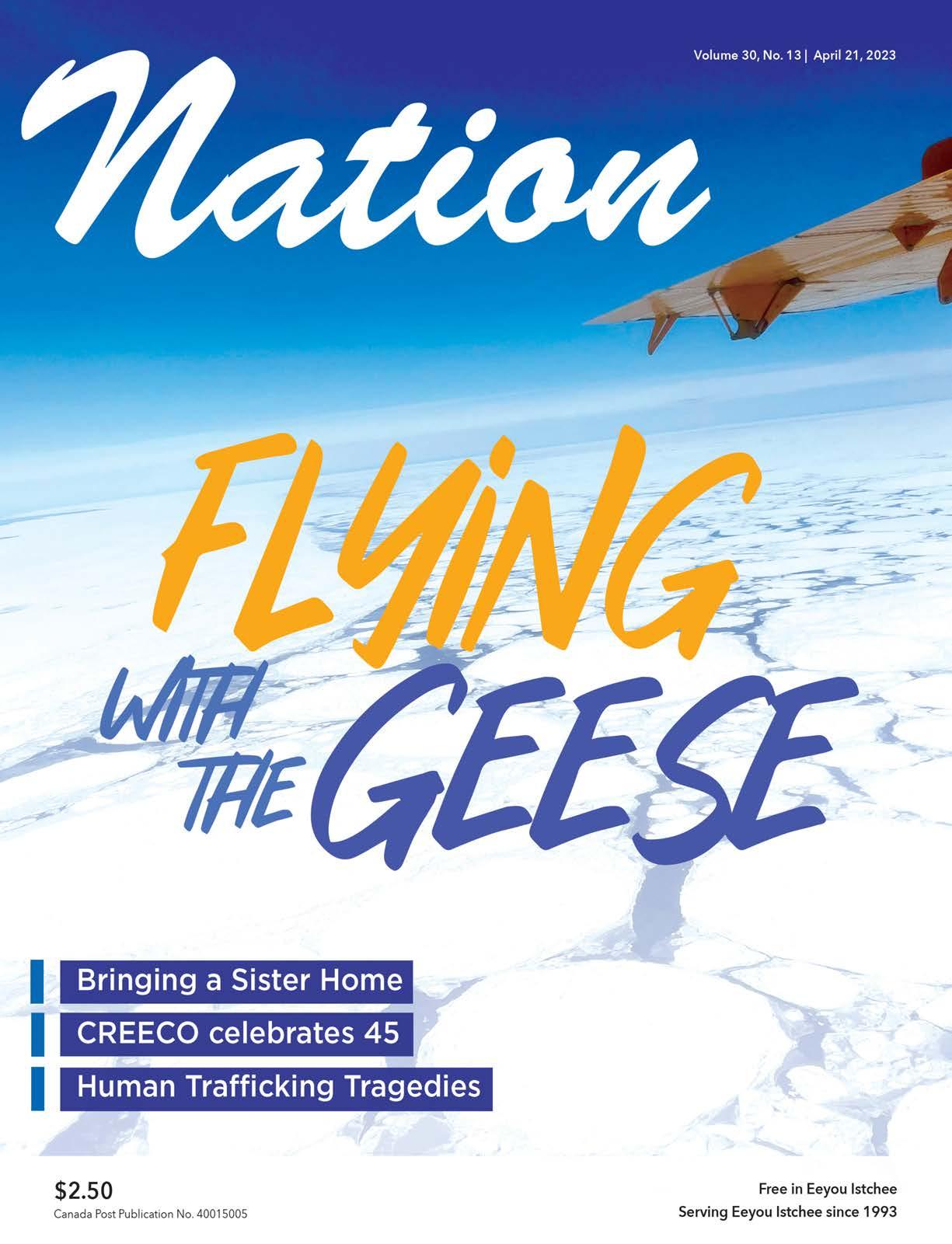

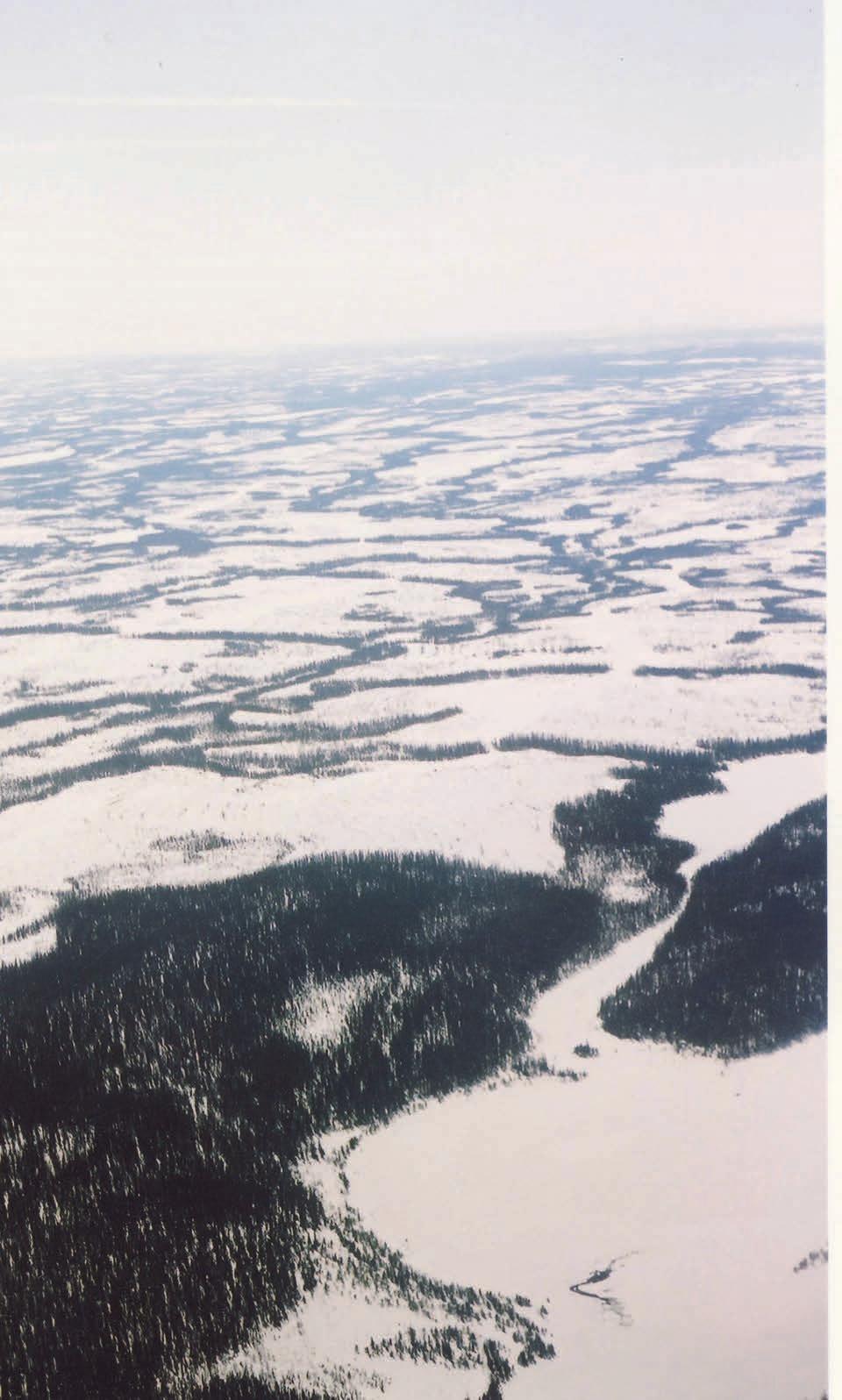
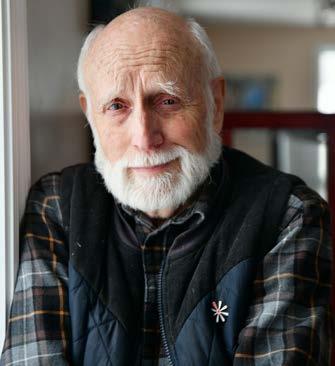
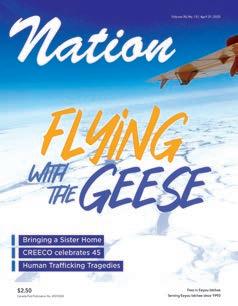
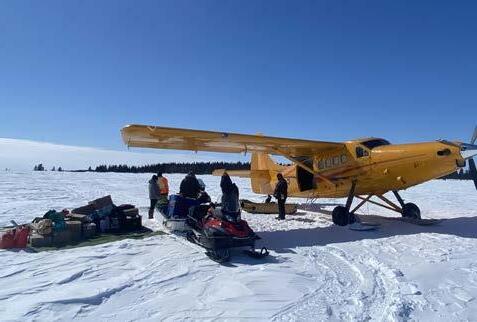




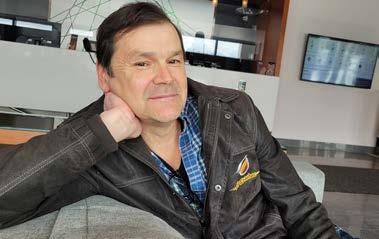

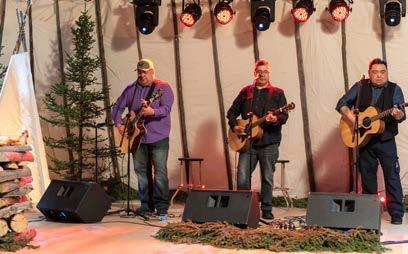
















The first goose hunt I went on wasn’t in the spring, but rather in the fall as the geese were heading south. You see, at the time my father was based at CFS Moosonee as the Assistant Fire Chief. He was an avid fisherman and hunter. So, when he felt I was old enough he took me goose hunting to the bottom of the James Bay.
We hunted in the flats, where setting up was different. You had to respect the tides for one thing. A few of our decoys were like ones you see these days, but others were made on the spot. Using a spade, you would cut the ground (clay and dirt) in an elongated triangle, then lift it up and smooth it out. Insert a stick into one end and put an empty toilet paper roll on top. Very crude but it worked.
A friend of dad’s, Joe Crawford, apparently had a decoy method that involved Kotex pads that worked quite well. However, at press time I was unable to reach anyone for details on this method. Maybe next year women will have competition when purchasing this product, if I can get details and diagrams.
I remember the shotgun hurting my shoulder so I would lay down and use a log to brace the butt when shooting. I don’t know how successful I was, but I remember it being an important time of my life. My dad placed great trust in me by putting a gun in my young hands. I know this is the same for many youth in Eeyou Istchee. It is one of the milestones of growing up.
Then, there were the jokes played on newcomers. One prank targeted a man new to the goose hunt. He didn’t even know what a goose looked like, so my

dad and his friends helped him out with a description. On the way back from the hunt everyone had to stop at the game wardens’ camp. They would check to see that you weren’t over the limit on geese.
Well, when this poor soul stopped, he was made to wait to see what a goose really looked like. He had shot seven seagulls which he was told carried fines of $50 each. The game wardens took pity on him, though. The would-be hunter exclaimed that the damn things were flying around him all the time. He mentioned how hard it was to shoot so many seagulls. With a smile they wished him better luck next year.
Another time they pitched their tent on a gentle slope. Another newcomer asked about groundsheets. They said there was one as part of the tent, but if he wanted to be sure a cheap way to ensure he wouldn’t get wet was to place some plastic under his sleeping bag. Of course, when he went to sleep, he slowly slid down the slope. It took some time for him to catch on to the joke.
We’ve all had jokes played on us at one time or another. When I left the blind to go for a washroom break, I arrived back and while waiting for geese a duck flew by. My fellow hunters generously, or so I thought, gave me first shot as I only had a single-shot 12-gauge shotgun. That’s when I found out they had removed the pellets from my shotgun shell. There was loud laughter all around – with one notable exception.
These days the spring goose hunt is even longer for some hunters as they travel south to hunt in farmers’ fields.
Nevertheless, it remains an important part of Cree culture. There is very little waste as almost every part of the goose is eaten. I think the only part not eaten are the feet. In the past, Cree women would weave and sew down into blankets so they would be warmer. In any case, almost every Cree looks forward to the goose hunt, whether it is spring or fall.
From all of us at the Nation, good luck to all hunters and stay safe.
•
• Property insurance, home or tenant or renter’s
•
P.L. Prasannam, B. Powless, N. Diamond, J. Loon, DESIGN Matthew Dessner, Ashley El Jachi SALES AND ADVERTISING Danielle Valade, Donna Malthouse THANKS TO: Air Creebec
CONTACT US: The Nation News, 918-4200 St. Laurent, Montreal, QC., H2W 2R2 EDITORIAL & ADS: Tel.: 514-272-3077, Fax: 514-278-9914

HEAD OFFICE: P.O. Box 151, Chisasibi, QC. J0M 1E0 www.nationnews.ca EDITORIAL: will@nationnews.ca news@nationnews.ca ADS: Danielle Valade: ads@nationnews.ca; Donna Malthouse: donna@beesum.com
SUBSCRIPTIONS: $60 plus taxes, US: $90, Abroad: $110, Payable to beesum communications, all rights reserved, publication mail #40015005, issn #1206-2642 The Nation is a member of: The James Bay Cree Communications Society, Circle Of Aboriginal Controlled Publishers, Magazines Canada Quebec Community Newspaper Assn. Canadian Newspapers Assn. Les Hebdos Sélect Du Québec. Funded [in part] by the Government of Canada. | www.nationnews.ca | facebook.com/NATIONnewsmagazine | Twitter: @creenation_news
The Office of the Cree Language Commissioner has received a fiveyear funding pledge, ensuring it will have money to expand its workforce and expand its range of programs and activities in the coming years.

The Grand Council of the Crees announced the agreement was signed March 30 between the Cree Nation Government, Cree Health Board, Cree School Board, and the Cree Board of Compensation. The funding amounts to $750,000 a year for the next five years, half of which is coming from the CNG.
“The Cree Nation Government is proud to support this initiative and looks forward to the important work the Office of the Cree Language Commissioner will be coordinating to ensure the protection of our language,” the CNG said in a statement.
“We appreciate the support we’re getting from these organizations. It’s a big step forward for us,” Cree Language Commissioner Jamie Moses said. “We’re
on the verge of posting a few positions to expand the team, and this will allow us to hire permanent staff for the Office of the Language Commissioner.”
Moses said the funding will allow the office to expand its current workforce of two by opening three or four positions this spring with the possibility for others by the summer. He said his office has been relying on the “support crew” from the Social Development Department of the CNG.
Two of the new positions will be in communications and language innovation. Moses, the first-ever Cree Language Commissioner, said the funding will allow his office to “support the communities at a greater scale” and assist them in acquiring more funding as well, he indicated.
“We’re also working in collaboration with the various entities that serve in the area of language – mainly the Cree School Board and to some extent the Cree Health Board, because it has a tra-
ditional healing department. So, we’ll be able to partner up with these people at a greater scale because we’ll have additional staff and people with expertise,” Moses added.
Moses said the commitment demonstrates that language is a priority for the Cree Nation and its entities. He said that there was no debate when his office put forward the funding request, and that they received positive feedback all the way.
With five years of funding secured, Moses hoped that the monies would eventually become continuous so that the office doesn’t have to scramble and not know if or when further funding is coming. He said the office can still seek funding from other sources.
“With recommendations from communities, to calls to action, there’s so much more to do,” Moses said. “Hopefully with the expansion of our team, we’ll be able to work on these projects and move forward with our office.”
For more information
Members of the Val-d’Or Chamber of Commerce gathered for a lunchtime presentation April 6 to hear from Neeposh, Valpiro President Matthew Happyjack and Vald’Or Quality Inn & Suites Director General Alexandre Audet.
CREECO, or the Cree Regional Economic Enterprises Company Inc., was founded in 1982 with investment from the Cree Board of Compensation to act as a holding company for Cree Nation investments in construction, air travel, hotels, catering, janitorial services, ground handling and fuel transportation through its multiple subsidiaries.
Neeposh explained that when the Cree Board of Compensation created CREECO, it “gave us the opportunity to really look at what our purpose was, as an organization, but more importantly, as a Nation.” Already, the Cree Construction and Development Corporation (CCDC) was up and running and became the first company under the CREECO fold.
“So, we had to gain very vast experience in terms of community building in such a short period of time. That allowed us to capture a lot of expertise in different fields,” he said, explaining that CREECO manages the subsidiary company, but not their day-to-day operations.
After Air Creebec was founded in 1982, six years later CREECO acquired Valpiro, which specializes in airport baggage-handling and fuel services. In 1996, the catering and janitorial firm ADC was created, before Eeyou Eenou Realty Properties Inc. (EERP) was formed in 2008.


Recently appointed interim president of CCDC, Neeposh used the opportunity to publicly announce that the board of

iyiyimiichim is healthy but lead shot is not!
LEAD SHOT IS TOXIC Let’s keep our families and environment healthy by using lead-free ammunition.
Make sure your gun can handle non-lead shot. It’s time to switch!Speaking to a crowd gathered at the Hotel Forestel in Val-d’Or, CREECO President Derrick Neeposh celebrated the Cree Board of Compensation’s 45th anniversary by declaring the Cree Nation and its companies as “open for business.”
directors had appointed a new president, Danny Pash, effective April 12.
“Danny brings to the company a vast knowledge of managerial experience and he also has a background in aviation, and it was his leadership style that really attracted us. We look forward to having a very positive working relationship,” Neeposh announced.
“We have big plans, and a lot of work ahead of us, Danny, so be ready,” he added, to laughter from the crowd.
In a statement, Pash, originally from Chisasibi, said, “I am very honoured to be appointed President of CCDC. I am looking forward to coming back home where I will be implementing a vision and strategies that will benefit the company and our Cree communities.”
Neeposh urged the new president to go beyond where the company is today and to explore innovative ways of doing business, saying the construction industry is very complex, with new technologies constantly advancing and requiring a constant investment in new technology and improving efficiency.
He pointed out that over 150 employees at the Cree construction firm were Cree, representing 63% of staff. A further 37% of employees have at least 10 years of seniority, which he said highlighted their loyalty.
Speaking to ADC, Neeposh said the firm’s primary goal is to hire and train Cree people. “Being a qualified janitor takes a lot of training,” he told the crowd, explaining how the company was forced to train and adapt even more to deal with stringent pandemic requirements.
When ADC split off from CCDC, he said there was initially much resistance from the board. However, he compared it to letting a child grow up and find their own path. “Today, we’re all proud of the fact that this company exists, and continues to grow,” he said.
Part of the company’s future depends on becoming more eco-friendly and investing in newer technologies, such as electronic cleaning equipment. The pandemic deepened its relationship with the Cree Health Board, as they took over provisions for patients at Hotel Espresso in Montreal and worked to supply them with traditional foods.
Neeposh said the Cree Nation initially secured property in Montreal that he and his business partner had protested while studying in college there. “Fast forward today, we’re leading the company that owns the property,” he said.
Then the City of Montreal began plans to redevelop the area, and they received offers of up to $40 million for the property. However, Neeposh said he rejected the
idea and pushed to develop their own building.
When they went back to the city with their concept, it was rejected by Montreal Mayor Valérie Plante’s office, who called it too generic. “A lot of developers would have been offended by that comment,” Neeposh said. “But we used it as motivation.”
After hosting a visioning session with Elders, they worked with architect Douglas Cardinal to come up with the current design, inspired by a canoe. “Before there were any railways or roads in our territory, our only means of transport was by canoe, so that is what the ODEA Montréal resembles,” he explained.
Neeposh concluded by praising the relationships that have formed between businesses and the two nations in and around Val-d’Or, pledging to continue working to form partnerships and joint ventures between Cree and non-Cree communities.
“It’s important to note that so much has transpired not only in terms of business, but the knowledge that all our companies have attained. It’s not only monetary investment, but it’s also investment of knowledge and the transfer of that knowledge.”
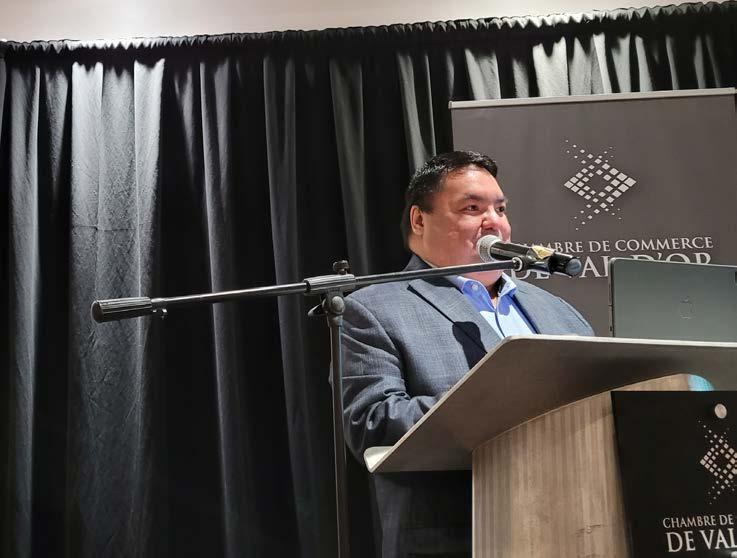








The Assembly of First Nations and the First Nations Child and Family Caring Society announced that a $23.4 billion settlement has been reached to compensate Indigenous survivors of the federal child welfare system.
The revised agreement adds a little over $3 billion to what was originally proposed by the federal government and the AFN in 2022, adding another 13,000 First Nations children to the existing settlement and ensuring children and families receive a minimum $40,000 payment.
“It’s a signal to these kids that the wrong has been done to them,” said AFN Manitoba Regional Chief Cindy Woodhouse, the lead negotiator on the file. “I’m glad that we settled this in an amicable way rather than in a courtroom.”
The compensation agreement covers three groups:
• First Nations children living on-reserve or in the Yukon taken from their homes and put into care from April 1, 1991, until March 31, 2022;
• First Nations children living on or off reserve, who were deprived of essential services or experienced delays with essential services from any government from April 1, 1991, until Nov. 2, 2017;
• Caregivers of all children.
“There’s going to be mental health supports, there’s going to be financial literacy supports, our team is going to start working to bring that all together,” Woodhouse said.
The Canadian Human Rights Tribunal (CHRT) had said the original deal did not meet the terms of its earlier rulings. Both the CHRT and federal government must still approve this agreement.
Compensation negotiations began in 2016 after the CHRT found that Canada discriminated against First Nations children in the provinces and Yukon because it paid less for child welfare services on-reserve than for services offered to children off-reserve. The proposed settlement is expected to compensate about 300,000 people.
FNCFCS executive director Cindy Blackstock argued the original deal needed to be stopped because too many children would be left out, including survivors who were sent to a home not paid for by the federal government.
“To truly honour them and the Residential School and 60s Scoop survivors we must ensure this is the last generation of First Nations children who are hurt by the Government of Canada,” stated Blackstock. “That work continues, and they are our inspiration to get it right.”
The Canadian government has announced $4.3 billion over seven years to address Indigenous housing needs. A portion of that funding will be focused on Northern communities, Northern Affairs Minister Dan Vandal told the CBC.
The funding includes $845 million for housing in Inuit communities. Some of the funding will also go towards reducing tuberculosis rates in the North, which has seen an ongoing outbreak in Pangnirtung since 2021. A further $150 million will go towards the three territorial governments.
Part of the federal government’s 2023 budget, the funding comes after the Nunavut government and Nunavut Tunngavik Inc. announced a plan to build 3,000 housing units by 2030.
Meanwhile, the Assembly of First Nations had been asking for a $44 billion funding commitment to address housing needs on reserves. Instead, the federal budget would allocate $2.4 billion for on-reserve housing. Métis communities are to receive $190 million in funding over the same period.
A working draft of Canada’s implementation plan for the
United Nations Declaration on the Rights of Indigenous Peoples (UNDRIP) met with disappointment and resistance at an Assembly of First Nations chiefs’ conference in Ottawa in early April.
In an emergency resolution, First Nations leaders urged the Liberals to amend the UNDRIP Act, to delay the plan or amend it after tabling it following more consultation. It wasn’t immediately clear whether the final resolution will urge amendments to the plan or the legislation itself.
“There’s a lot of back and forth on it because there isn’t 100% consensus that Canada’s UN declaration act is in the best interest of First Nations,” said National Chief RoseAnne Archibald.
Archibald said the plan’s language around free, prior and informed consent must be strengthened. The resolution said the consultation process led by Justice Minister David Lametti was rushed, leaving “grossly inadequate time” for First Nations to provide input.
Lametti said the rushed timeline was a compromise with former AFN National Chief Perry Bellegarde, who wanted it finished in one year. He said it will be a “focal point for intense discussion over the next three months.”
Former NDP MP Romeo Saganash originally brought forward legislation to align Canadian laws with the UN declaration, which affirms the rights of Indigenous Peoples to self-determination and to their language, culture and traditional land. It was finally passed in 2021, which stipulated that the government must return to Parliament with an implementation plan by this June.
As Eeyou Istchee prepares for another Goose Break, the Nation reached out to local Cree Trappers’ Associations (CTA) and public safety officers across the communities to get updates on goose sightings, ice conditions and other safety concerns for those preparing to head out this year.
Chisasibi CTA administrator Reggie Bearskin said there hadn’t been any sightings in the community yet, but that community members were starting to move material out to their camps. He said the community has ice monitors, who will be announcing ice conditions on the radio.
However, Bearskin advised that there’s lots of open water on the river due to the hydroelectric installation. It is fine to travel south by snowmobile, but to travel north community members should go by plane or go 40km out of their way overland to avoid the open water.
In Eastmain, Thomas Stevens of the CTA said they were expecting the geese to be a bit late this year, perhaps arriving the week of April 17.
“Right now, ice conditions are pretty good. A lot of the hunters are still travelling by skidoo, but there are still parts of James Bay where lots of people aren’t able to go to camps because of so much open water,” he said, particularly near Strutton Islands, where planes are being used to fly people to camp.


Stevens said that people will have to return by helicopter because the ice will be gone by May when Goose Break is over. He advised those heading out to follow all relevant safety precautions, especially ensuring that children don’t get access to loaded firearms.
“We have a lot of younger generations that started to go hunting at a younger age. Some of them still don’t have firearms licenses when they start using guns, so it’s important as parents or guardians that you always explain how procedures are with firearms, and make sure the gun is unloaded when in camp,” he explained.
Stevens advised those heading out to listen to Elders and others on ice conditions to ensure the ice is thick enough for travel. He also urged people to supervise their camps so that children aren’t playing with fire.
“I just want to make sure we have a safe Goose Break. Making sure that we spend time with our families and kids and spend time with the Elders – they pass down all the traditional knowledge, we have to listen to them,” he added.
Eastmain Public Safety Officer Ivan Gilpin said that the open water was six kilometres away from the community as of April 4, adding that the winter was long but not particularly cold. He said schools would close in the community May 1-12.
Gilpin encouraged those travelling for Goose Break to “just listen to our river monitor when it’s time to close the river. Stay put where you’re going to be for the rest of Goose Break.”
Nemaska CTA administrator Mabel Rabbitskin said there hadn’t been any goose sightings in the community, but people were busy preparing, taking their belongings to the beach. She said the ice was still solid and hadn’t started to melt and was still safe for travel.
She said the community, in collaboration with the Cree Health Board, is hosting a bush training session April 18-20, for those who want to learn first aid and emergency preparedness. Those who are interested should contact her.
Ouje-Bougoumou Fire Chief Stanley Bosum said people weren’t setting up camps yet but getting camps ready for flyout. He indicated the ice is “still pretty thick” and that it’s still safe to head out by snowmobile. The schools will be closed May 1-12.
He advised community members to check the ice thickness and weather conditions before they head out. “Some of the rivers are the ones that are pretty tricky – just snow on top of water.” He urged residents to “enjoy their holiday and take a breather when they’re out there to relieve the stress,” he added with a laugh.
In Waskaganish, CTA manager Darryl Salt said that there hadn’t been any goose sightings, but that he expected them to arrive around April 12 or 13, as the weather had been warm then cold.
He advised that some parts of the ice were very thin, while others were still thick. He said initial flyovers showed a lot of open water near Charlton Island, which he said was nearly unprecedented, so community members will have to use a bush plane to get there.
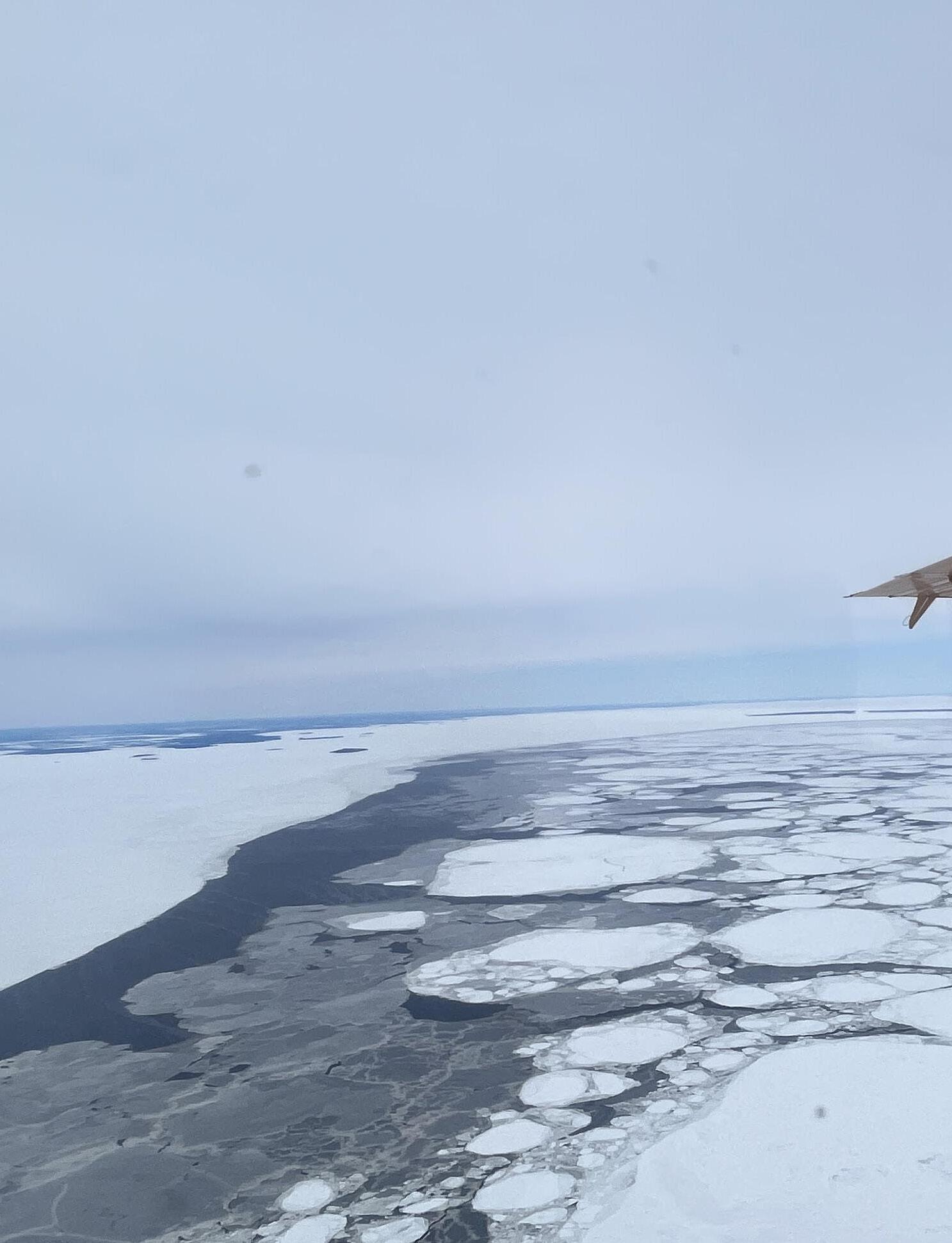
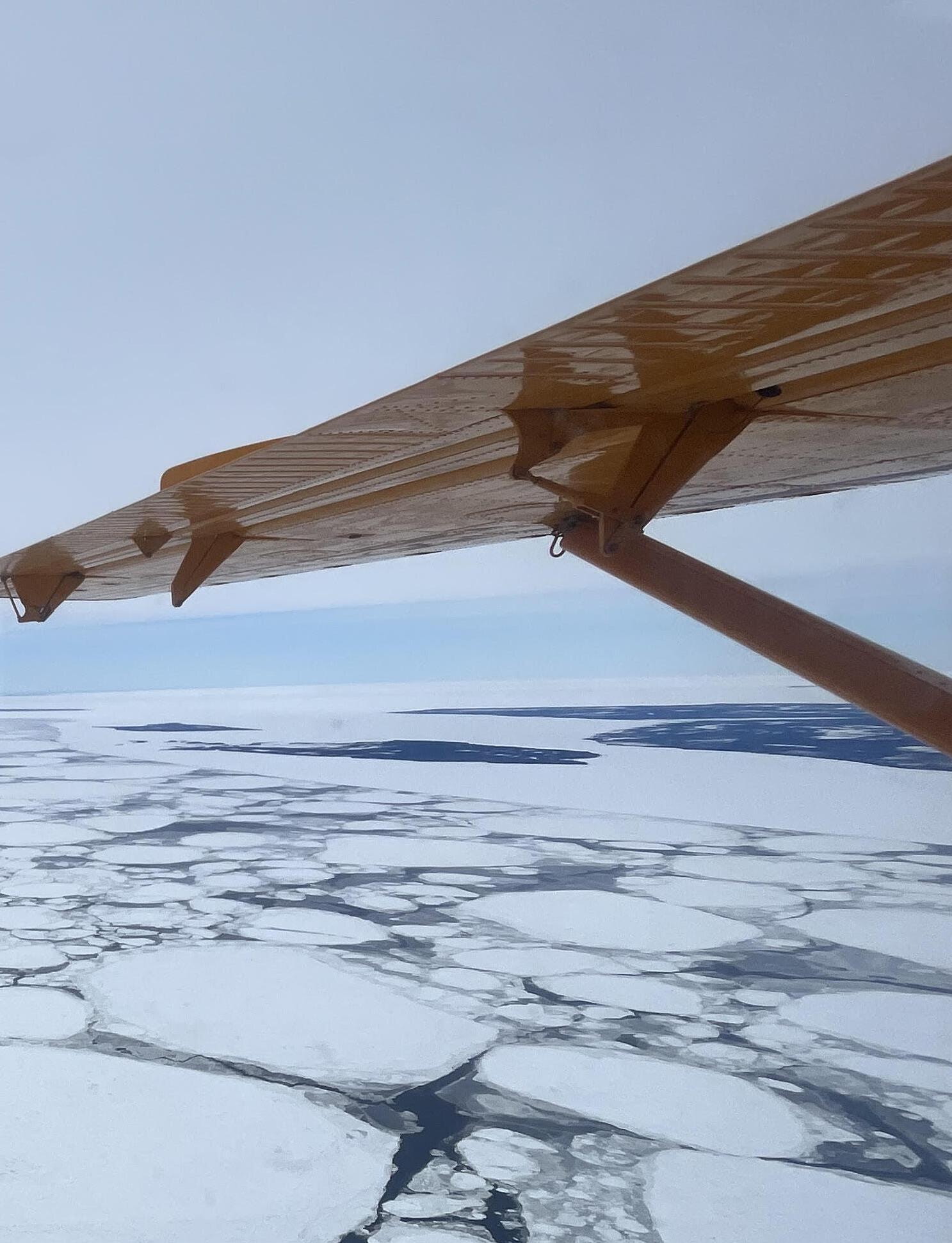

“For Goose Break safety concerns, we’re asking our people to move fast before warm weather comes,” Salt said. The CTA will have an Elder who will provide radio updates about conditions. Goose Break is scheduled to begin on April 22 in the community.
“Be safe out there, always look at weather ahead when you plan your trip, always listen to your Elders, that’s the best advice you can get,” Salt added. “Don’t try to be Superman out there thinking ‘I don’t need help’ – no, you always need help, that’s my advice.”
Jonathan Prive, dispatcher for Air Tunilik, advised community members to take a detour if travelling to Charlton Island because of nearly 70 miles of open water between Jacob and Charlton islands. “For us, the ice condition around the island is safe to land on the ice with our plane,” he said. He advised residents to book with the CTA if they need their cargo flown up.
In Wemindji, CTA Executive Director Tyler Coonishish said there had been no sightings, but that he expected geese to start returning around the week of April 24. He said the ice was still solid and they would be meeting with land users and tallymen to get their input on ice conditions. “But we’re hearing from a few people that it’s looking better than last year.”
He said the CTA has an Eeyou Marine Coordinator who will be giving updates every two weeks, based on satellite imagery and consultations with land users, which will be necessary, because the weather has been unpredictable.
A representative of the Whapmagoostui CTA said their office would only be open after April 17. The Nation was unable to reach any representatives in Mistissini or Waswanipi.

The time has again come to take part in a Cree tradition that has been with us for many generations. The time we will be spending on the land will not only strengthen our identity as Crees but will also strengthen our family and community bonds. We encourage everyone to be mindful of safe practices when hunting and take all of the precautions necessary to make this a memorable season. Our safe participation this year will further ensure that this tradition stays with us for many generations to come.
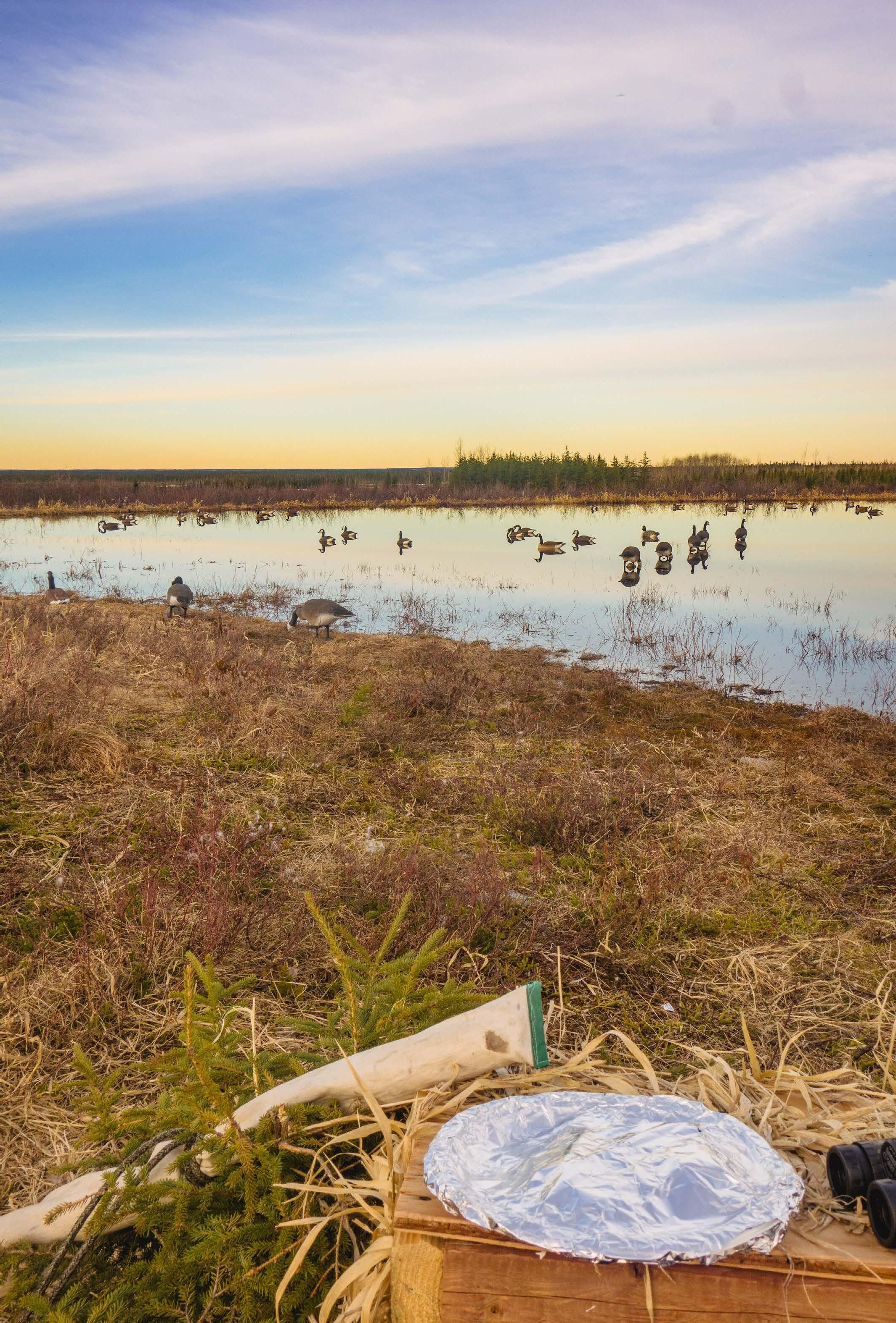
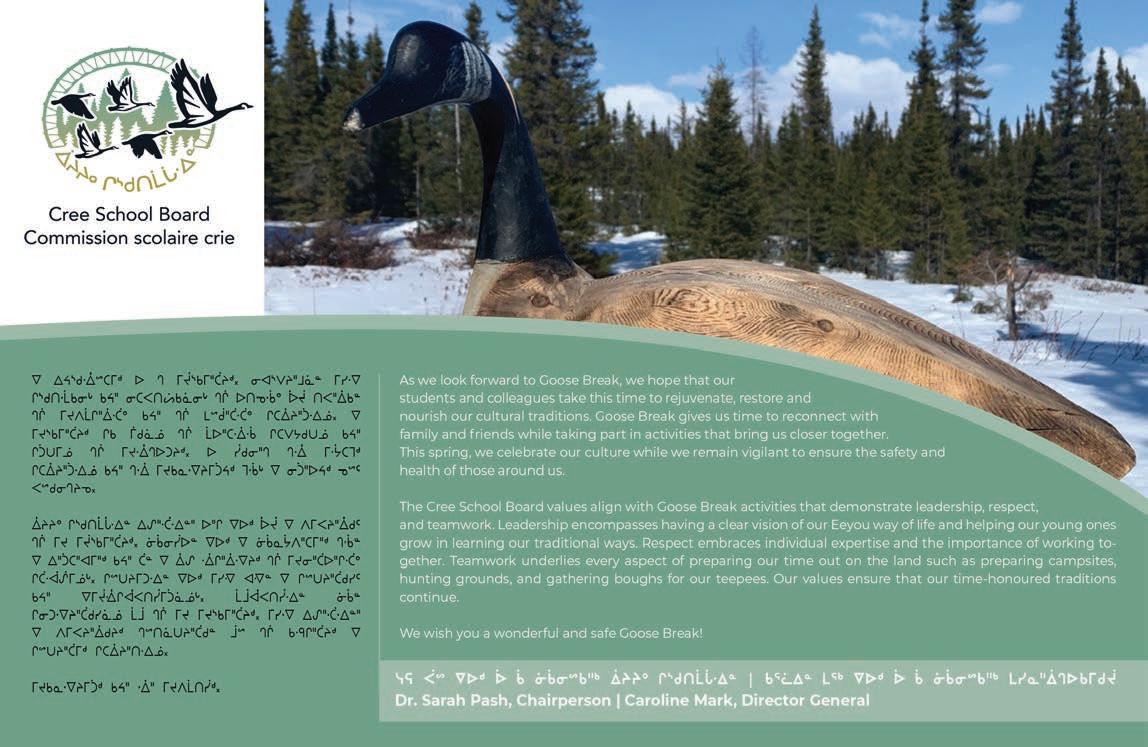



 Archaeologist Jim Chism
Archaeologist Jim Chism
Jim Chism is busy digging through boxes and opening files filled with documents and photographs when I meet him at the Waskaganish Cultural Institute. Jim has been digging around Cree territory since the early 1970s, just after the James Bay Project was announced. His is a familiar face for people from Chisasibi, Eastmain and Waskaganish.
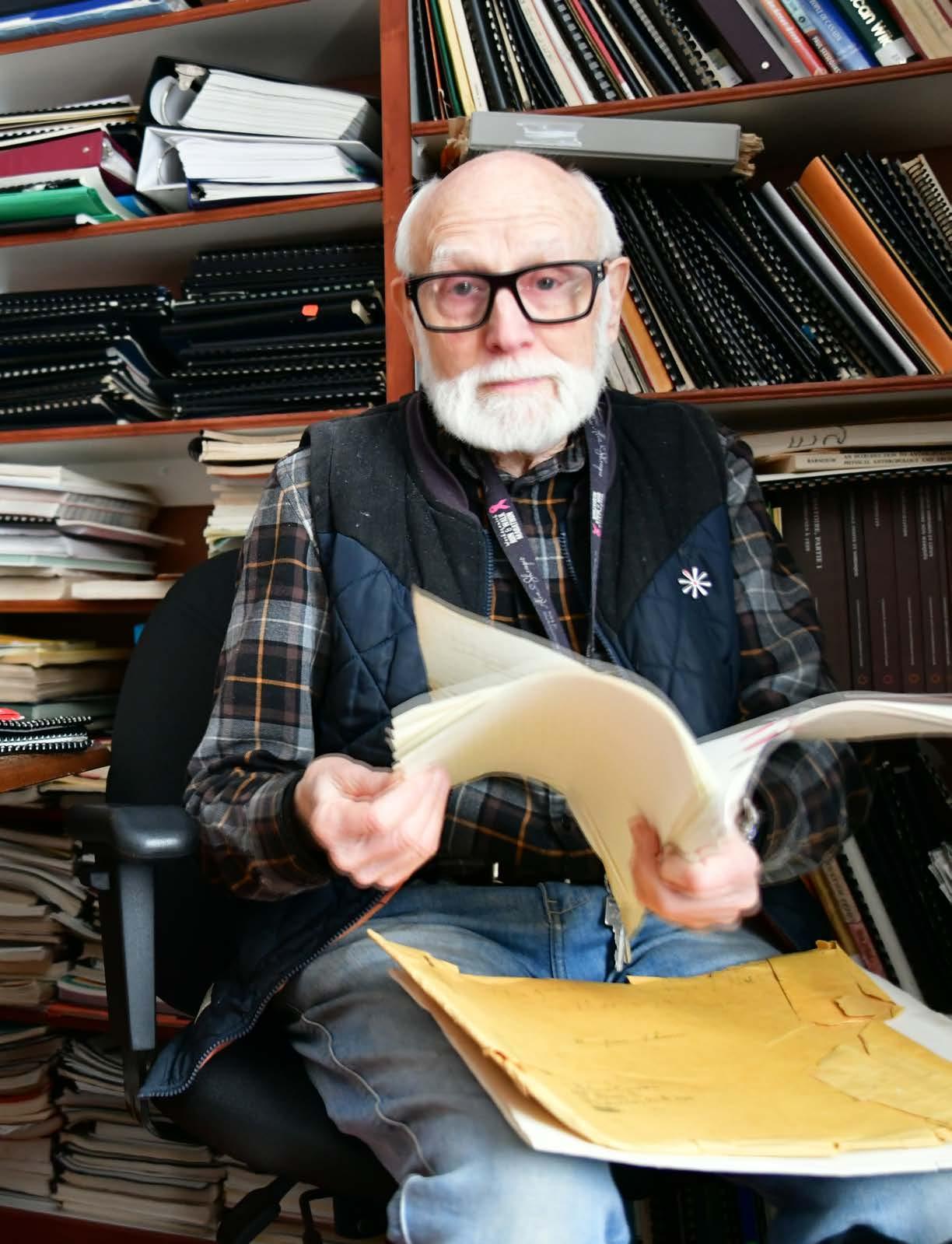
Jim was born as a heat wave baked his parents’ small town of Conway Springs, Kansas, during the Great Depression. “They thought I wasn’t gonna make it,” he remarks. His father fashioned an air conditioner by hanging wet straw over an open window and blowing a fan through it.
Jim’s father was a truck driver, drove a taxi, worked in a pool hall, a grocery store, in the prairie oil fields building wooden oil derricks, and eventually ran a tree nursery and flower shop. His mother worked as hard as his father.
Jim also worked after his lessons in a one-room schoolhouse that held two groups of students. He graduated from high school after the family moved to Anthony, Kansas.
“High school was pretty easy. I hated maths and algebra and things like that, but I liked geometry and physics. I could never remember all those formulas. I liked sciences. I had the toughest science teacher you could ever imagine. She would browbeat the students and ridicule them.” But years later he and his fellow students remembered her as their best teacher.
Jim entered university in Lawrence, Kansas, in 1956 with the intention of going into medical genetics. All through high school he read everything he could about biological sciences.
“I got it in my head that I was going to discover how to make people live forever. Do away with old age. Now I’ve decided that it would be the biggest mistake in the world, to have people living too long. We already have an overpopulation problem. Imagine what it would be if no one was dying off and people still wanted to have kids.”
Before beginning his second year of university, friends were all taking a course in anthropology. They told him it looked like it might be a lot of fun and why didn’t he come take it with them?
“Unfortunately, it seduced me,” he laughs. “That summer I volunteered to go on a dig in Buffalo, New York. I had to get from Anthony, which is almost in Oklahoma, so I hitchhiked all the way.”
The following summer they asked Jim to come back, this time for a paying job. He bought a small 1950s red Cushman Eagle motor scooter to get him to Buffalo.
“I’d never been on a scooter in my life. The first day I had it, my dad was in the front yard with me, and I cranked it up. I couldn’t control it and I bounced over the curb. My dad did not look very happy!”
This was before the days of America’s interstate highways when it was just backroads and narrow twolane highways. On the three-day trip to Buffalo Jim slept by the roadside and under bridges and trees when it rained.
Later Jim rode that scooter through Arkansas, Nebraska, Oklahoma, Missouri and Kansas visiting archaeological sites.
In Buffalo, Jim worked at a construction site which had an early-contact Iroquoian burial ground with a lot of grave goods and artifacts rescuing them before they were destroyed by bulldozers and backhoes.
Before completing his BA in 1960, Jim enlisted in the US Army and found himself stationed in Nuremburg, West Germany. The Berlin Wall was being built; the Cuban Missile Crisis was heating up.
“We were a little concerned because our base was the old SS barracks next to what was supposed to become the ‘capital of the world’, sharing this honour with Berlin, and we knew we were zeroed in because that base had two nuclear warheads. We knew if anything did happen, we would be the first to go.”
After a few years, Jim moved to Winnipeg as a research associate at the University of Manitoba handling contracts with Parks Canada. He worked at Lower Fort Garry for three years before moving again to Ottawa for National Historic Sites. “I ran around all over Canada checking on excavations or doing reconnaissance, looking for old fur trading posts.”
He travelled the Peace River by boat to trappers’ camps, getting stuck on sandbars. There were grizzly bears and black bears around and when he’d see bear poop, he would sing loudly to scare them off.
Jim was offered a job in South Carolina to excavate the Charleston colonial settlement.
“There were parts of that deal that didn’t appeal to me. It was mainly a racial problem, a paternalistic problem. I was informed that everyone working for me would be Black. I was expected to be their patron. If they needed cigarette money, I was expected to take care of them, look after them like some kind of godfather.”
He thought it rather a strange way to work, so he was not disappointed that the funding fell through.
Then Jim came to James Bay, the other end of the environmental spectrum. The James Bay Project had only recently been announced.
“I looked around and nobody was doing anything about the archaeological question at all. I went to the National Museum and said, ‘Look, they’re getting ready to build a road up through James Bay and nobody’s even looking! Why don’t you give me a contract to follow the route from Matagami up to Fort George?’” Jim was hired.
With two others, Jim headed north with a backpack, a 30.30 rifle, inflatable boat, freeze-dried food, sleeping bag and a light tent.
“We would come wandering into construction camps with hunting knives and our rifle and they would look at us and say, ‘Check your guns at the bar, boys!’”
Jim and his companions were sometimes airlifted to sites by helicopter. At recently abandoned Nemaska, it looked like the people had just left the day before.
On Peat Island upriver from the Rupert River bridge, they found a beautiful large winter camp with everything still standing. Different kinds of tents, racks for storage.
“Everything was laid out for you like you stepped back in time,” he marvels. “Archaeologists spend half their lives scraping around trying to figure out the pattern of how people lived, what did these ancient camps look like, and dig and dig and dig. All we had to do was look and there it was just laid out. It was pretty darn clear it was done on traditional patterns.
“We started wandering around on lakes to see what we could find, and we’d record it.” Then Jim asked himself, “Why aren’t we doing this in the company of the people whose hunting territory it is?” So, they found some Cree people to work with.
They camped at Caniapiscau far inland from Fort George. They lived with Job and Mary Bearskin, David Pashagumskum and his wife Daisy, Frances and Abraham Pachano, Johnny Fireman Sr. These people would become their teachers.
The Bearskins, the Pachanos and the Pashagumskums weren’t just show-
ing them places where archaeologists had gone to look for old camps.
“Swamps!” exclaims Jim. “Archaeologists keep forgetting there’s snow in the winter and you can camp at places you wouldn’t think of camping in the summer, right? There’d been an otter winter camp there. Not in a million years would an archaeologist think to look there!”
Jim was on the water with Johnny Fireman when the old trapper stopped the boat telling him this was his spring camp.
“We were in the middle of the lake so the plane could see him. There were no radios yet. We had a better chance of understanding how the Cree were using the land than the archaeologists coming and finding a summer camp.”
They were shown different camps in the area from five years before and even from 100 years before that. “I wouldn’t dream of going in the bush and trying to do something without someone knowledgeable of that area.”
Jim hired two young Cree, Steve Pashagumskum and Fred Georgekish, recently graduated from a Native
Studies program at Trent University to be interpreters and work with the Elders.
“David Pashagumskum said he liked that arrangement because it gave him his first real chance to have his young people with him in the bush and to explain what they were doing and how they were living. It was also a way to pass something on to another generation, the generation responsible for recording it and feeding it to us so we could understand.”
Jim remembers especially Job Bearskin.
“Job’s house in Fort George was organized just like a bush camp! The door faced east. The woodpile was in front of the door just like in camp. You came in, and he had his fire closer to the door than the back of the house. His stove was sitting on a ring of stones with sand and in the back was where you would sleep, and he had stuff stored around the perimeter. It could have been a tent. You could have taken away the walls, put up a frame and canvas and it could have been a bush camp.”
Jim went on to excavate sites in Eastmain, Waskaganish, Washagami, Eastmain, Sakami Lake and the old trad-

ing post across the river from Fort George Island. In Waskaganish, he helped find Iroquoian-looking pottery at a prehistoric site by the canoe factory. There were old pipe stems near the La Sarre Air Services base and other 17th century objects lying on the open ground. He also located two English forts by the river’s shore which hadn’t been clearly identified in archives. They were also signs of skirmishes between the French and English when the two nations vied for control of North America.
Jim now has semi-retired to a small village in Denmark. The place where his distant forefathers might have come from. According to the Dictionary of Surnames, Chism is an Ulster corruption of the Scottish Chisholm, which the book traces back to the Norsemen term for “The Chief”.
What’s clear is that the “Chief” loved working with the Cree. And Jim considers himself lucky that there was a generation of people who could teach him about our culture.
Then a sad tone enters his voice. “Every time one of them passes away,” he says, “it’s another volume in the library that just got burned.




Local Journalism Initiative Reporter
The first-ever Cree Knowledge Festival, an online event broadcast live from Chisasibi March 25-26, is being called “a resounding success” by its organizers at the Cree Native Arts and Crafts Association (CNACA), Cree Outfitting and Tourism Association (COTA) and Cree Trappers’ Association (CTA).
“The organizers did an incredible job, giving viewers a small taste of Eeyou Istchee,” said Chisasibi Chief Daisy House. “As there is so much more to explore, we hope this festival encourages mandowch (visitors) to travel to our paradise in the North and experience our land – which to us, is medicine for the mind, body and soul.”
While organizers intend to focus on different Cree communities in future editions of the festival, CNACA executive director Gaston Cooper said that this time “we wanted Chisasibi to shine.” The community was instrumental in the event’s success, from the talented local performers to the set design, audio and catering.
behind the scenes at the Mitchuap Building with other producers and French-language interpreters connecting from Montreal. George Diamond spontaneously developed the inviting teepee backdrop days before the event, bringing over poles and tarp with the help of his grandsons.
Although viewership numbers are still being compiled, an estimated 1,900 people watched the live events while the promotional videos reached over 200,000 on social media. The broadcast reached viewers as far away as France.
“The majority of people who joined were [Québécois], which was exactly what we were hoping for,” Cooper told the Nation. “There was one woman from California thanking us. Their culture has been lost and with just a glimpse of Cree culture it touched her heart.”
Cooper said the most popular panel was the discussion with Chief House and Grand Chief Mandy Gull-Masty, breaking down common misconceptions about the
and explaining key aspects about the culture along with certain issues like the longstanding housing shortage.
“The online platform provides greater access to those who want to know about the Cree way of life,” stated Gull-Masty. “I am so proud to participate in this first-ever innovative showcase.”
While COTA had discussed launching a festival since before the Covid pandemic to highlight the importance of Cree traditions and values, this virtual event demonstrated the growing interest in Eeyou Istchee, setting the stage for tourists to visit a larger gathering in summer 2024.
Throughout the open platform, host Christopher Herodier interviewed Cree leaders and knowledge keepers with occasional questions from audience members delivered by co-host Lori-Jane Pepabano. A fancy shawl performance by Miss Chisasibi, Delayna Cox, was an opportunity to announce that Chisasibi’s
During the second panel, CREECO president Derrick Neeposh was joined by the Cree Heath Board’s Bertie Wapachee and Cree School Board’s Sarah Pash to show how the entities’ projects are often interrelated. For instance, Pash said that new nursing and home-care training will be introduced next year to prepare for the regional hospital being built in Chisasibi.
Although the primary audience was non-Indigenous people beyond the territory, much of the dialogue was in the Cree language with plenty of wisdom for locals to learn from. Cooper said organizers wanted to gather and preserve Elders’ teachings, helping youth to better connect with their cultural heritage.
In segments shot on the land last summer, Eddy Pash discussed the healing power of nature and Dwayne Cox sang a traditional song with a hand drum. Cox shared that hunters long ago would dress ceremonially in red to improve their

looks after large animals.
Janie Pachano recalled the legends and teachings she learned at a young age and returning to Eeyou Istchee after living in California to become involved in the struggle against the mega-dam in the 1970s. Disturbed by misinformation published about her people, she embarked on a 40-year project that resulted in the 2020 publication of the book Chisasibi and Its People.
“I kept wishing somebody Cree would write about us so our children would know the truth,” said Pachano. “I tried to set the record straight. I figure my purpose in life is to leave something behind about our culture for the younger generations because we’re gradually losing our language and our legends.”
Pachano’s research took her to Ottawa, Winnipeg and the Northwest Territories. She also shared insights learned about walking-out ceremonies and first contact with European traders. According to the story, a shaking tent
what looked like trees in the bay. Against advice, one man paddled to the ship and returned singing strangely in different clothing.
In the festival’s final part focusing on local artists, Margaret Orr shared how Cree traditions inspired her art and explained how caribou hides would historically be traded for the birch bark used as canvas. As artisans created snowshoes and moose-hide slippers, Herodier wandered between them to ask questions about their process.
CNACA’s new Wachiya online store launched on March 31, so it was a perfect time to showcase Cree artisans. The website wachiya.com is a platform for a wide variety of Cree arts and crafts, available ahead of a planned opening of a physical store in Montreal’s Old Port later this year.
Musical performances from Cree Rising and fiddler Jayden Ratt were another highlight. Diagnosed with global developmental delay, Ratt surpassed
ing himself how to play from YouTube videos at age 10.
“Jayden afterwards was walking around with the biggest smile for the next two days,” said COTA’s Rob Imrie. “It was incredible to see how well he played. Everyone was congratulating him because his performance was amazing, but his smile was huge!”
With excellent feedback from viewers, organizers are already thinking about the next festival. Cooper suggested that they will emphasize the major role bush food has in Cree communities, one aspect that was lacking from this inaugural edition. For those who missed it, the festival can be replayed at cree-festival-cri.com.
“Here’s an avenue for people outside of Eeyou Istchee to connect with people from the area,” asserted Imrie. “Daisy said come visit us – our doors are open and you’re welcome. People need to hear that.”

On April 3, the Board of Directors of the Cree Construction and Development Company (CCDC) announced that Danny Pashagumskum has been appointed as the company’s new president.

“We are extremely happy to welcome Mr. Danny Pash on board the CCDC team,” stated Derrick Neeposh, president of Cree Regional Economic Enterprises Company (CREECO). “He is a great addition to the CREECO family. His extensive experience in leadership positions and in strategic planning will be a strong asset for the company.”
CCDC is the largest of CREECO’s companies and the largest Cree-owned company in Canada. Its steady growth since its creation in 1976 has earned it a good reputation and it is the first Canadian compa-

ny owned by First Nations to earn and maintain ISO certification from the International Organization for Standardization.
With over 30 years of experience within the private, public, regional and national levels, Pash will take over the lead role from Robert Baribeau, who announced his departure in September. Hailing from Chisasibi, Pash is a proud father of two known for empowering people to produce positive change.
“When I saw the CCDC posting, I knew it was perfect for me,” Pash told the Nation. “I’ve been looking for an opportunity to come back home, to transition back to my roots. I’m sick and tired of living in Ottawa, the two-hour commutes. Now the time is right, and I look forward to the change.”

Pash spent his childhood on Fort George Island where his parents were teachers and “absolutely loved it there.” Moving later to Val-d’Or, he worked as a pilot with Air Creebec, a company he stayed with for nearly 10 years.

When given the opportunity to expand his knowledge and abilities, he transitioned to Air Transat, Canada’s leading holiday travel airline. As a pilot there for 11 years, Pash flew Boeing 757, Airbus 330 and “a little bit of everything.”
“It was a real privilege to have some of the best training in the world, flight simulator training, pilot management,” said Pash. “I obtained a level of knowledge where I could either stay there and become comfortable or continue to expand my knowledge and skillset. I went to NAV Canada – they have a lot of success with taking people out of the operations and putting them into the business world.”
NAV Canada oversees air traffic throughout the country’s civil airspace and North Atlantic through a sophisticated network of control and maintenance centres, flight service stations and navigation aids. Pash began in the company’s finance department then migrated to instrument procedures design, where he started training new recruits.
“As you know, aviation is a heavily regulated industry,” Pash said. “Working with standards and training really honed my business acumen, dealing with stakeholders. You have to know how to navigate the industry well. That set me up to be in a position of standards and regulation.”
Feeling he had hit another level of achievement at NAV Canada, Pash was ready for another career change. With extensive experience in governance, working in a senior role within a large and complex environment, he was excited to present his candidature for the opening at CCDC.
“When an opportunity presents itself, one thing I’ve learned over the last 30 years is it’s best to jump on it,” asserted Pash. “CCDC has a lot of parallels with aviation in terms of security, safety and regulation along with leadership and governance. I thought to myself, this is the perfect fit to apply my knowledge and experience and transition into a parallel field, the construction industry.”
While Pash already has some ideas for growing the company, he’s planning to first sit down with the CCDC team to better familiarize himself with its current operations before defining its next objectives.
“Aviation is the epitome of streamlined operations so perhaps we can look at that at a later time,” explained Pash. “One standard for any Native business is to continue with Native employment so that will be a factor from the start. I will be implementing a vision and strategies that will benefit the company and our Cree communities.”
We are proud to continue supporting your community by enriching exchanges and ensuring the success of our collaborations.


GOOSE BREAK CAMP SAFETY CHECKLIST
Get a carbon monoxide detector
Have one already? Change the batteries!
Update your vaccines (COVID-19, tetanus)
Switch to lead-free shot
Review gun safety guidelines
Boil your water
Store it in food-safe containers
Yâkwâmi! Be careful to prevent injuries
Manage camp trash
Pack it up or burn downwind
Be prepared for emergencies
Test your radio/cell phone

Bring a bush/emergency kit to camp
Dogs need vaccines too
Make sure your dogs’ rabies vaccine is up to date
GOOSEchecklistBREAK
CO2 detector
Lead-free shot
Emergency bush kit
WE WISH YOU A SAFE GOOSE BREAK AND A GOOD HARVEST!
creehealth.org/bush-camp-safety
creehealth.org/services/womens-shelters-robins-net
Emily Rabbitskin was washing dishes at home in Mistissini when her cellphone rang. The caller asked her if she could be part of a project that would help many survivors of residential schools.

yelled out to Caroline, saying, “Make sure both of you take care of our special daughter and bring her back.”
remember everything that happened,” she said.
Rabbitskin dropped everything she was doing. She sat at the kitchen table, and tears began to flow. She remembered the promise she made more than 50 years ago. After calming down, she took a deep breath and wiped her tears, pretending nothing had happened. She whispered to herself: “It is time to tell what happened.”
The story is retold in E nâtamukw miyeyimuwin (Towards well-being), a collection of personal accounts by James Bay Cree storytellers written by Ruth DyckFehderau that was published in March.
In the book, Rabbitskin recounts her close relationship with her late twin Juliette. They were more than best friends, she says. Growing up with her, Emily knew how to communicate with Juliette, who was deaf and mute and suffered from Down syndrome, though it wasn’t diagnosed at the time.
Juliette and Emily were nine years old when they were sent to residential school. Caroline Shecapio, Emily’s older sister, was with them when they got in a floatplane. Caroline still remembers the moment; Juliette’s father, William,
Caroline often wonders why she remembers that moment and William’s words. Maybe the universe wanted to tell her something, or it was just a coincidence.
In the spring of 1966, Juliette passed away, still aged nine, in La Tuque due to complications of an outbreak of a virus at the school she attended. After more than five decades, Caroline and Emily are now finally telling Juliette’s story.
Emily and Caroline never made it to Juliette’s funeral. They were both sick because of the virus outbreak. However, Emily and her brother, Morley, went to La Tuque Cemetery to visit Juliette’s grave. They couldn’t find it. They searched everywhere, and they were about to give up when Emily saw a grave from a distance all alone. She asked her brother to check it, and Morley said it was Juliette.
“I cried so much because this hurt me; her grave was all alone,” said Emily, who made a promise as she stood beside the grave. “We are going to bring you home.”

Caroline still feels emotional when she tells her side of the story. She sat on her bed to read her part in E nâtamukw miyeyimuwin story book. “I could not go further because it was too painful; I
One of Caroline’s granddaughters resembles Juliette’s character – she is kind, soft, gentle and loves everyone. “My granddaughter brings love into the family; she brings a family together; Juliette was like that too,” said Caroline.
Kathleen Rabbitskin was Juliette’s younger sister. She first attended residential school in 1969, three years after Juliette had passed. Even though she went to the same school for years, no one ever told her she had another sister, and her grave was only a 10-minute walk away.
When Kathleen was 19, she overheard Emily and Caroline talking about someone who resembled the late Juliette and asked who that was. They responded that Juliette was her older sister.
This boggled Kathleen’s mind, and she began to wonder what had happened to her older sister and why her parents had never told her. “I did not want to ask my parents because it is too painful for them,” said Kathleen.
When Kathleen was young, she remembered her parents used to be very affectionate toward one girl who lived in the neighbourhood; they would hug her and buy her toys. Kathleen thinks the girl reminded them of Juliette.
If you are an Indigenous woman of Eeyou Istchee and you are seeking safety and support, we are here to help you!
If you need emotional support or to learn about all the services available to you, please contact us:
A collection of residential-school reminiscences captures the heartache of separation and loss
Then, when Kathleen gave birth to a daughter, she named her Juliet. “When I first held my baby, the only name I could think of was Juliette,” she said.
Reverend Bruce Myers is the Anglican Bishop of Quebec. He attended the Truth and Reconciliation Commission (TRC) in 2013 as a representative of the Anglican Church. He first heard the story about Juliette from another Mistissini community member, Mary Coon-Come.
In May 2021, unmarked graves at an old residential school in British Columbia made national news. Myers saw the information and wanted to check if his district had a similar situation.
“There was something about what happened in Kamloops in the spring of 2021 that just seemed to bring it to the attention of non-Indigenous Canadians in a way that it never had before,” said Myers.
He remembered the story of Juliette that he had heard at the TRC and wanted to do something about it. “One of the TRC’s 94 calls to action was to help bring the remains of children who died at residential schools to their home communities,” Myers noted. “I asked our archivist for our diocese to go through our archives again to make sure that there were no other deaths at the school that may not have been recorded.”
Myers checked to ensure Juliette’s grave was marked with a proper headstone with
her name in English and Cree syllabics. He confirmed that everything at La Tuque Church about her death and funeral was recorded correctly.
Myers wanted to contact the Rabbitskin family but didn’t know how. He got in touch with an Anglican priest in Mistissini, Reverend George Westgate, to ask him to approach the Rabbitskin family to see if they would like to discuss bringing Juliette home.
“The response was almost immediate, positive, and it was yes,” said Myers.
He also contacted government authorities to ask for help with the exhumation. It has since been confirmed, but the exact date is not set. Myers hopes this process will bring healing and closure.
Myers wants to formally apologize to the family and the broader community because many people from Mistissini and the James Bay Cree found their way to residential schools.
The Anglican Church was involved, and he wanted to express his regret because he believed Juliette’s death at such a young age was likely preventable if she had not travelled to La Tuque to attend that school and fall victim to an infectious illness.
“Who knows how long she might have lived if she had been able to stay in her community with her family,” Myers mused.
What is happening?
April 3, 2023 — The Impact Assessment Agency of Canada is conducting a federal environmental assessment for the proposed Timiskaming Dam-Bridge of Quebec Replacement Project, located on the Ottawa River, at the border between the provinces of Quebec and Ontario.
The public and Indigenous Peoples are invited to comment on the potential environmental effects of the project and the proposed measures to prevent or mitigate those effects as described in the proponent’s summary of the Environmental Impact Statement.
Visit the project homepage on the Canadian Impact Assessment Registry (reference number 80151) to:
• Learn more about the project
• Submit your comments online by 11:59 p.m. on May 3, 2023. All comments will be published online.
• Attend an information session about the project and assessment
Have questions?
Scan the QR-Code for more information about the project, the process, and the information sessions or to visit the project homepage.

Write to us at Timiskaming-Temiscamingue@iaac-aeic.gc.ca or visit the Agency”s website at canada.ca/iaac.
For media inquiries: media@iaac-aeic.gc.ca or 343-549-3870.





Local Journalism Initiative Reporter
The tragic drowning of eight people attempting to cross illegally into the United States has shone an unfortunate light on the Kanien’kehá:ka (Mohawk) community of Akwesasne, which straddles the Ontario, Quebec and New York state borders and is divided by the St. Lawrence River.
The reserve’s unique geography has long made it a popular smuggling conduit for tobacco, drugs, weapons and people. With Akwesasne’s Casey Oakes still missing in connection with the deaths, Grand Chief Abram Benedict said that the tragedy has taken a toll on the community of 20,000, particularly on the first responders who helped with the search.
“The tragedy that struck our community has tested the fortitude of our first responders to possibly an unprecedented level,” posted Kyle Lazore of the
Hogansburg Akwesasne Volunteer Fire Department. “It’s a sombre atmosphere, and you can see the weariness in their faces. Some wander off to be alone ... then they’re back at it again, with what seems like a tireless effort, in hopes of bringing closure to a grieving family and community.”
Akwesasne Mohawk Police Chief Shawn Dulude said his officers have made 48 interceptions involving 80 people trying to cross the border through Akwesasne since January. In February, local police issued a statement of concern about the increased human smuggling, which was frequently resulting in hospitalization for migrants and putting first responders at risk.
Some immigration advocates warned the closure of the unofficial border crossings at Roxham Road in Quebec last month would push des-
perate migrants to riskier areas. In response to the Akwesasne tragedy, Immigration Minister Sean Fraser said he was reconsidering the root causes behind these crossings.
Although unconnected with this recent case, an Ontario man named Simranjit Singh was charged the following week, alleged to be the “primary organizer” of a human smuggling network using Akwesasne territory. After brokering a deal with migrants, Singh allegedly would pay Akwesasne members $2,000 to $3,000 per person to transport them into the US.
When locals were complaining that the easy money of cigarette smuggling was slowly corrupting parts of the reserve decades ago, former Grand Chief Mike Mitchell blamed the federal government for not heeding his alarms

and ignoring requests for more positive business development.
“We all know that [organized crime] will use the Akwesasne territory as a corridor for the movement of illicit goods, and that the Canadian government will use the Mohawks of Akwesasne as the scapegoats,” Mitchell wrote then-prime minister Jean Chrétien in 1998.
With gunfire from rival crime groups often making the river unsafe at night over the years, some have gotten rich as community tensions have escalated. What some call a right to Native sovereignty, others call morally reprehensible. The implication of certain locals in these smuggling operations complicates the response of Indigenous law enforcement.
“Smuggling has been happening for centuries,” said JoJoe Van Hooser, a youth protection worker in Ottawa from the Bay of Quinte Mohawks. “But when somebody dies, that’s when it hits the papers and becomes an issue. If they’re trying to get the traffickers who could be family members, it affects the community as a whole. I could be a police officer, but my brother might be smuggling babies or cigarettes.”
Working for the Children’s Aid Society by day, Van Hooser is also involved with several Ottawa organizations fighting human trafficking (HT), including the restorative home for sex-trafficked youth, A New Day. She volunteers on the streets at night, going “undercover and (helping) the girls get out of human trafficking.”
“The human trafficking ring goes down (Highway) 401, transported through Montreal, Toronto and Ottawa and out of the airports,” Van Hooser told the Nation. “We know there is human trafficking in Akwesasne. The waterways are one of the biggest ways of getting the girls across the different borders.”
According to Public Safety Canada, about half of human trafficking victims are Indigenous women. The average age of recruitment into the sex trade is just 13 years old. On March 23, Akwesasne’s Sierra Caldwell spoke in public for the first time at the Anti-Human Trafficking Day of Learning in Long Sault, Ontario, about being a sex-trafficking victim two decades ago, when she was 14 and growing up in Austin, Texas.
“I survived this for a reason,” Caldwell told the CBC. “I want people to know that it could happen to their sister or daughter. If I had known how to show signs, if my mother had known how to decode certain signs or ask questions, I could have been saved from the start.”
Patrick Dussault, the former anti-human trafficking liaison for the Akwesasne Family Wellness Program (AFWP), said three women from Akwesasne had received services as victims of sex trafficking in the last five months. The AFWP told the Nation that Dussault was no longer with their program, and they declined to comment on recent events.
Dussault said pimps often take the guise of loved ones, so girls don’t initially realize they’re being trafficked as
their community ties are severed. Van Hooser said there are even parents that groom and pimp out their own children.
“When our beautiful cousins from the North come into the city, it’s absolute culture shock,” Van Hooser noted. “They don’t know what to look out for, then they’re very vulnerable. There should be a protocol where they’re connected to someone to help them navigate that important information.”
Montreal’s Iskweu Project has worked to connect Indigenous arrivals with support services, including prevention kits at the bus station where pimps are known to target girls. The Cree Women of Eeyou Istchee Association emphasized the importance of these safety measures after a young Cree woman shared that she was a victim of human trafficking at the Lac Lemay Casino last summer.
While governments are providing increasing resources to combat human trafficking, Akwesasne Grand Chief Benedict asserted that funding has been insufficient to address the complexity of the issue, both in terms of law enforcement and prevention.
“Human trafficking affects the community as a whole because it’s our people who may be partaking in it and also dying in it,” Van Hooser explained. “It’s not just Akwesasne with the smuggling at the border. Everyone needs HT training, especially the 101 toolbox to keep children safe.”
“I survived this for a reason,”
Another Goose Break is upon us, exercise your right to harvest with utmost respect and great pride.
Uphold our traditions and values to share our harvests with elders, single mothers and widows. Practice our values, safety on the ice, in our hunts or around our camps.
As always, let us enjoy our time out on the land with family and friends, and in honor of those who are no longer with us.
 Bertie Wapachee, CBHSSJB Chairperson
Bertie Wapachee, CBHSSJB Chairperson

Wishing everyone a safe and successful Goose Break! troilusgold.com
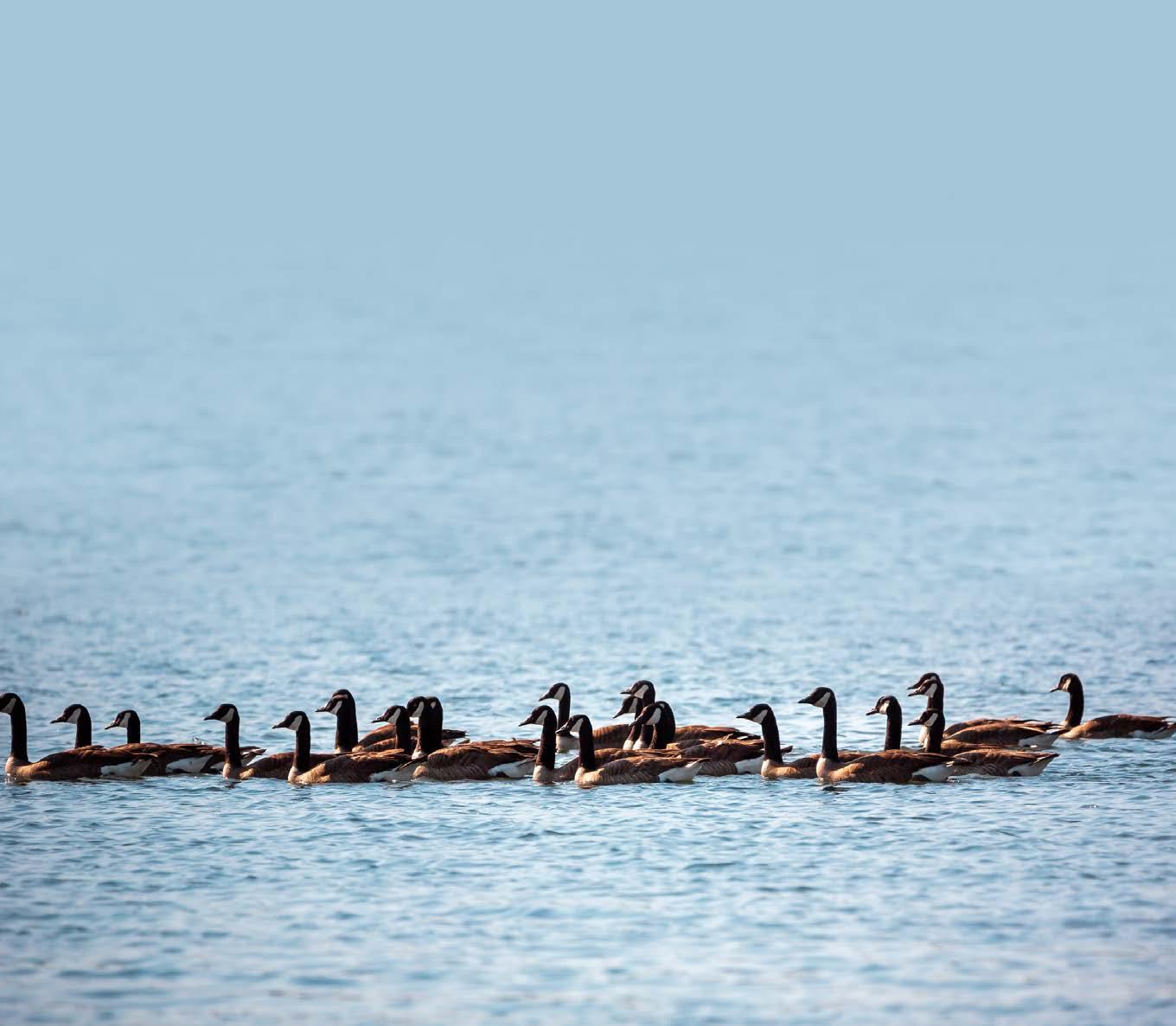


For women and children of Eeyou Istchee suffering from domestic violence
For women and children of Eeyou Istchee suffering from domestic violence
For women and children of Eeyou Istchee suffering from domestic violence
Toll Free | Open 24/7
For women and children of Eeyou domestic violence
For women and children of Eeyou Istchee suffering from domestic violence
Toll Free | Open 24/7 HELP
Toll Free | Open 24/7
creehealth.org/services/womens-shelters-robins-net
Toll Free | Open 24/7
creehealth.org/services/womens-shelters-robins-net
creehealth.org/services/womens-shelters-robins-net
Pîpîchâu Uchishtûn | Robin’s Nest | Women’s Shelter
/services/womens-shelters-robins-net
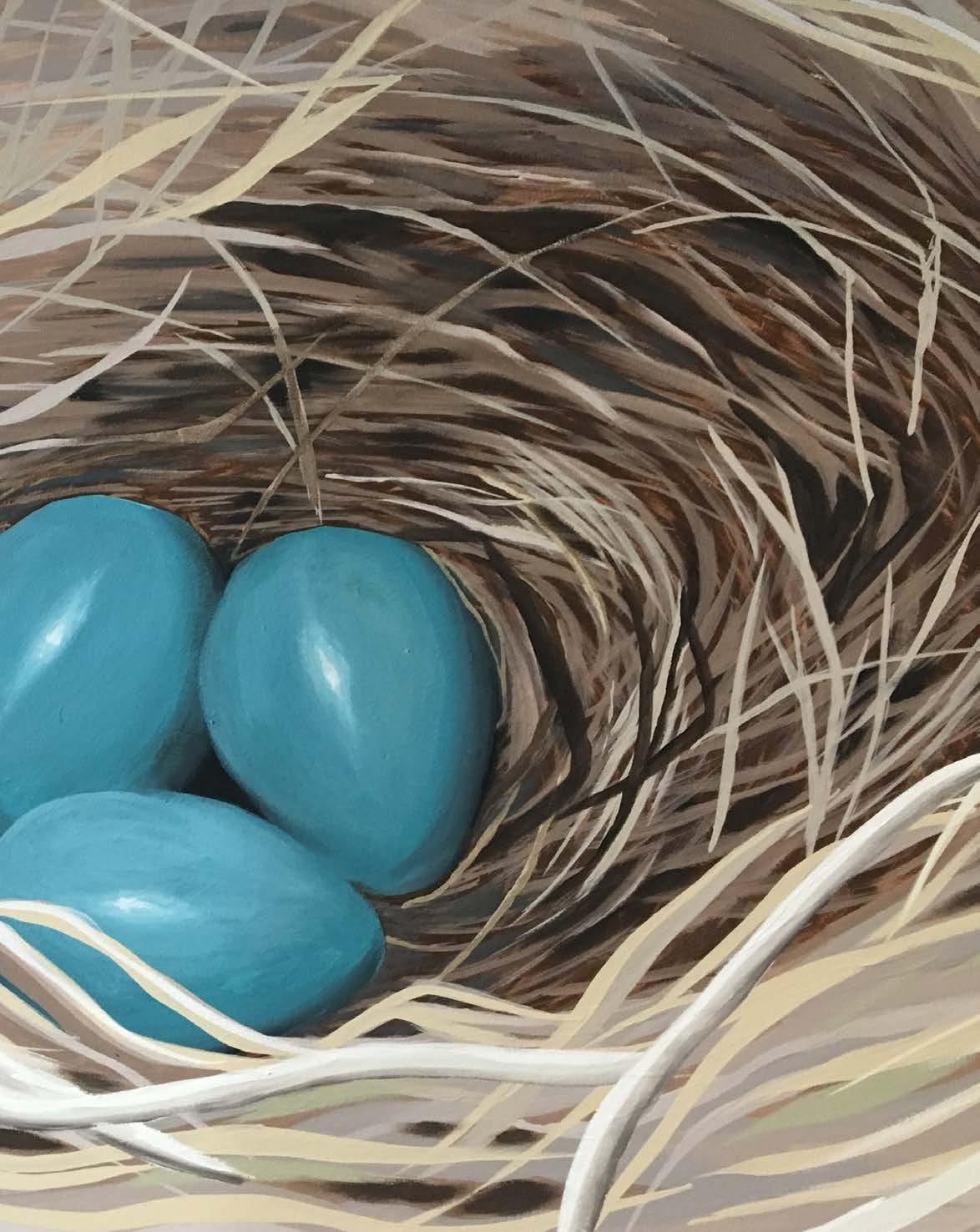


Pîpîchâu Uchishtûn | Robin’s Nest | Women’s Shelter
creehealth.org/services/womens-shelters-robins-net
Pîpîchâu Uchishtûn | Robin’s Nest | Women’s Shelter
If you are an Indigenous woman of Eeyou Istchee and you are seeking safety and support, we are here to help you!
Pîpîchâu Uchishtûn |
If you are an Indigenous woman of Eeyou Istchee and you are seeking safety and support, we are here to help you!
If you are an Indigenous woman of Eeyou Istchee and you are seeking safety and support, we are here to help you!
If you are an Indigenous are seeking safety and support,
Pîpîchâu Uchishtûn | Robin’s Nest | Women’s Shelter
If you are an Indigenous woman of Eeyou Istchee and you are seeking safety and support, we are here to help you!
If you need emotional support or to learn about all the services available to you, please contact us:
If you need emotional support or to learn about all the services available to you, please contact us:
If you need emotional support or to learn about all the services available to you, please contact us:
WÎCHIHÎWÂUWIN HELPLINE
WÎCHIHÎWÂUWIN
HELPLINE
If you need emotional support or to learn about all the services available to you, please contact us:
creehealth.org
creehealth.org
creehealth.org
WÎCHIHÎWÂUWIN
creehealth.org
emotional or to learn services please
WÎCHIHÎWÂUWIN
creehealth.org



Ahhhh… the sound of water dripping off icicles hanging from power lines, the slight crackling sound of electricity grounding out on a vehicle. Wait, isn’t this an ice storm?
/services/womens-shelters-robins-net
Sorry folks, I don’t want to make fun of the country dealing with nature’s latest (and hopefully last) outburst of winter. I look at my studded tires, wondering if I should keep them on for another month. Perhaps there will be a last-minute superstorm complete with hail, tornadoes, ice and snow, to remind us that global warming is just a farce and shouldn’t be taken seriously during the winter months.
My granddaughters are quite good at calling geese and when all four of them start calling for fun, it sounds like a gaggle of geese anxious to eat and rest. Now it’s just about teaching them how to stay cool and not move around to get a better selfie view. Practice makes perfect I always say.
As for winter, the last hockey tournaments have ended, and the players are back home. A Facebook posting indicates hockey season is not yet over and another tournament is still scheduled somewhere. But I digress and send apologizes to the empty golf courses that are just waiting for the sore losers to hit something else with a stick for the rest of the summer.
As hockey season wraps up, the next topic, of course, is the annual spring goose season. Hunters are readying themselves, preparing their packsacks and blinds, changing the belts on their snowmobiles, and introducing their daughter to the fine art of the goose call. I notice that even for myself, my goose calls are a little lower on the octave and a higher-pitched call might work better.
The local hunter and trapper gangs are busy sorting out the new members and lining up aircraft to get to the hunting territories. This year, the cost to go hunting is increasing like crazy. It seems that the price of fuel and oils to fill up your snowmachine or outboard motor is getting so high that the sleds need to be bigger and longer just to keep the number of trips down to a minimum.
The last person I saw at the pump coughed up a hundred bucks for the gas and another hundred for the oils, So, a day excursion is not feasible anymore, unless you are heavily subsidized, or you know someone who is rich enough to afford a daily trip. I guess it’s back to walking a few hundred yards to get to the goose blind.
As far as stashing up on the daily grub, I remember when we had to forage around for any small game and cook it over the fire to get by. I notice that no one hunts the squirrel, which is a tasty snack. Now, squirrels are regarded more as a pest than a source of nutrition and are left for the dog to chase after.
As far as pets are concerned, the use of dogs to retrieve your shot (or injured) goose is on the rise. I’m more of a cat person, as cats are quiet and are naturally predatory and will feed themselves when hungry with that pesky squirrel or any other nasty rodent. But cats don’t take to swimming and fetching very well. I guess it’s a compromise all round. Bring the girls to do the goose calling, bring the dog to retrieve your goose and bring the cat for pest control in the cabin or tent.
Most important of all, stay within cellphone range to keep everyone’s attention glued to their screens, while you keep watch with your trusty binoculars. Back in the day, when things got slow, we would drift off and catch some shut eye, then awaken with a face burnt red by the sun’s rays. So, remember to bring sunglasses and suntan lotion.
If you can’t kill anything to brag about, at least you will have the burn marks to show that you tried to put some protein on your table. Back in the day, it was a matter of survival, but today, the hunt is helping to offset the rising food costs. No matter what, the goose will be hunted and plucked for someone’s supper. Stay safe this spring and watch out for all the usual dangers like falling through the ice, burning your bare skin, or fighting off rodents.
Happy Goose Break everyone!

woman of Eeyou Istchee and you support, we are here to help you!
Ioften talked about the fact that when I got sober almost five years ago, I really thought my life would get easier instantly and that most of my problems were because of the addictions I developed to cope with trauma. I was expecting to do much better overall, especially socially, but as time went on, I realized there was still something off about me.

I am particularly aware of it when I have social interactions; being around other people feels like acting. It gets overwhelming because I have to think of everything: my stance, my facial expressions, forcing myself to maintain eye contact, and trying to conceal my hands shaking from anxiety.

People know it and it’s kind of a running gag. I spend a lot of time alone because I bury myself in my work, but also because I avoid social settings when I can. I quite enjoy alone time and people close to me have always struggled with that because they expect me to express love, friendship, intimacy and support the way most people do.
Since I was a teenager, I’ve seen countless healthcare professionals for my mental health and was misdiagnosed many times. They tried a lot of treatments and I failed most of them. Trying different medications that would make little to no difference or make my symptoms worse has been taxing on my health and body.
Like many other women, I was diagnosed with the entire DSM-5 (the big book of mental disorders) before they realized what’s up with me.
Often, autistic women will be diagnosed much later in their life than men, because they tend to mask symptoms better and because doctors will brush them off as being difficult, crazy or dramatic. The profile doctors used to diagnose it would always be of the typical non-verbal and apathic variety.
This overlooks the great diversity of what autism can look like. Society has higher expectations toward women, so the ones living with autism naturally learn how to conceal certain traits for survival. However, having to keep up with societal standards with a condition that affects how you interact with others, communicate, learn, and behave can lead to exhaustion, and will be so traumatizing for the body that autistic adults often experience “skills regression”.
That’s basically what happened to me. I started losing the ability to blend in with “normal” people, because my body didn’t have the energy to do it anymore. So, at 27, I received an autism spectrum disorder diagnosis.

My whole life, I was told I was too much. Or not enough. The feeling of never being able to grasp or reach what people

expect of me socially has been excruciating, especially since I got off booze and substances that I used to take to make social interactions and life in general more bearable. I’ve always been told that I was dramatic, difficult, cold, blunt, nonchalant, intense, depressing, careless or straight up weird, and I always hated myself for it.
Although my diagnosis brought me relief and answers, I also regret all the things I could have been if I had been diagnosed in childhood with tools that could have helped me achieve my goals. My ASD gives me many gifts, especially the ability to retain information. I have a more positive view of myself now that I know better how my brain works, but my heart often aches for younger self. She was so confused and scared, and all she needed was safety and support.
Often, autistic women will be diagnosed much later in their life than men, because they tend to mask symptoms better and because doctors will as being


